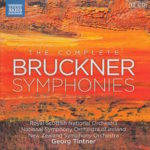 This morning’s conductor of Anton Bruckner’s Symphony No. 5 in B-Flat Major (WAB 105) – nicknamed “Tragic,” “Church of Faith,” or “Pizzicato” symphony (for reasons I’m still discovering) – is Georg Tintner (1917-1999), the Austrian-born composer/conductor with whom I was already familiar (and dare I say fond?) prior to starting my 144-day exploration of Bruckner’s music.
This morning’s conductor of Anton Bruckner’s Symphony No. 5 in B-Flat Major (WAB 105) – nicknamed “Tragic,” “Church of Faith,” or “Pizzicato” symphony (for reasons I’m still discovering) – is Georg Tintner (1917-1999), the Austrian-born composer/conductor with whom I was already familiar (and dare I say fond?) prior to starting my 144-day exploration of Bruckner’s music.
I own a couple of other recordings conducted by Tintner, and like them immensely.
Plus, if memory serves, I think I heard Tintner on the local Classical radio station (WBLV FM) a time or two, perhaps even leading a Bruckner symphony.
In this project, I first encountered Georg Tintner on Day 15 (Symphony No. 1).
Then, on Day 31 (Symphony No. 2).
And again on Day 47 (Symphony No. 3).
Most recently, it was on Day 63 (Symphony No. 4).
 It’s hard for me to stifle a squee when I merely touch this Tintner box set from Naxos. It’s so well constructed! Visually, it’s a thing of beauty. Aurally, it’s…
It’s hard for me to stifle a squee when I merely touch this Tintner box set from Naxos. It’s so well constructed! Visually, it’s a thing of beauty. Aurally, it’s…
Well, I’ll wait with that until a bit later.
First, the objective aspects of this recording:
Bruckner’s Symphony No. 5 in B-Flat Major (WAB 105) composed in 1875-1876
Georg Tintner conducts
Tinter used the 1878/80 version, edited by Haas
Royal Scottish National Orchestra plays
The symphony clocks in at 76:46
This was recorded at Henry Wood Hall, Glasgow, Scotland on 19th and 20th April 1996
Tintner was 79 when he conducted it
Bruckner was 51 when he finished composing it
This recording was released on the Naxos label
According to its entry on Wikipedia,
1878 version
This is the version normally performed. It exists in editions by Robert Haas (published 1935) and Leopold Nowak (published 1951) which are almost identical.
Bruckner wrote his symphonies in four parts. The time breakdown of this one (Symphony No. 5 in B Flat Major, 1878/80 version, edited by Haas), from this particular conductor (Tintner) and this particular orchestra (Royal Scottish National Orchestra) is as follows:
I. Introduction (Adagio) — Allegro. B-flat major……………………………20:19
II. Adagio. Sehr langsam. (Very slowly) D minor……………………………16:42
III. Scherzo. Molto vivace D minor…………………………………………………14:11
IV. Finale (Adagio) — Allegro moderato. B-flat major…………………..25:50
Total running time: 76:46
From the Tintner-penned liner notes about Symphony No. 5,
In the gigantic and heroic Symphony No. 5, one looks in vain for the slightest bit of self pity. His great predecessor Beethoven also suffered, with even more reason, from much self-pity, and sometimes also exaggerated the gravity of his finances; but his music is also totally free of it, as though these master put their works through a purifying filter. How different from some of the other important composers like Mahler and Tchaikovsky, whose self-pity may well have been one of the mainsprings of their inspiration and musical expression.
The Fifth Symphony, the most intellectual of all Bruckner’s works, is further removed from the seductive world of Wagner’s harmony and orchestra. Just why this work and the Sixth Symphony, which exist in just one version each, escaped his obsessive reworkings we will probably never know.
“The most intellectual of all Bruckner’s works,” perhaps explains why it’s been so difficult for me to get into this one. Intellectual is not what I’m looking for. I want a symphony to move me emotionally.
That phrase also explains why I can appreciate this symphony for its construction, take it in as a whole, but not find anything “clever” (as I consider them) in small parts that I feel like sharing with someone else.
Okay. Now, here are the subjective aspects:
My Rating:
Recording quality: 5
Overall musicianship: 5
CD liner notes: 5 (extensive essays about Bruckner and his symphonic style written by Tintner)
How does this make me feel: 5
Everything about this box set from Naxos is first rate.
The music is outstanding. The liner notes are the best I’ve read, save for those from Eugen Jochum in the “white” box set (from the DG label). The recording is well balanced and clear. The brass is not harsh or brassy.
This performance is the aural equivalent of a Hemingway novel. It’s flawlessly constructed, briskly paced, and without any extraneous notes.
To me, this sounds like a story, flowing from one chapter to the next.
And I am hooked on every “word,” caught up in the telling of it.
“Huzzah!”
